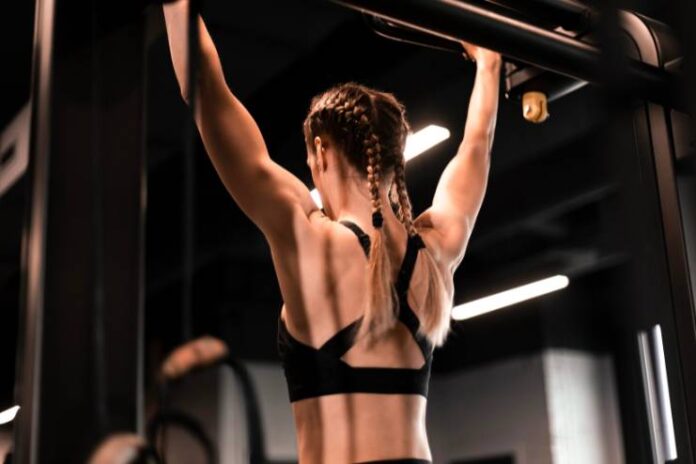Affiliate Disclaimer
Some links in this article are affiliate links. We may earn a small commission if you make a purchase through these links, at no extra cost to you. We only recommend products we find useful to our readersFriday Flex, the ultimate guide to your upper body workout for strength and definition, is here. The goal of this workout is to develop and define each muscle in your arms, shoulders, chest, and back. Upper body workouts are a crucial part of total fitness since they not only enhance muscle endurance and correct posture but also enhance upper body strength vital for daily activities and athletic performance. Whether you’re a seasoned gym-goer or fitness newbie, this workout is sure to help you achieve your fitness goals in no time. Get ready to flex those muscles and transform that upper body!
Warm-Up
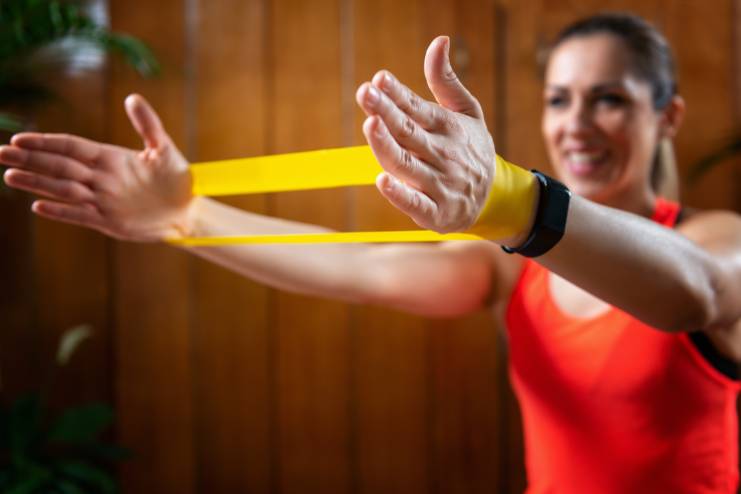
Get your blood pumping with 5-10 minutes of dynamic stretches prior to your upper body workout. This is important for increasing blood flow, enhancing flexibility, and reducing the risk of injury.
- Arm Circles
- Stand tall with your arms extended out to your sides.
- Rotate your arms in small circles forward for 30 seconds, then switch directions for another 30 seconds.
- Gradually increase the circle size for the next minute, maintaining tension in your arms.
- Shoulder Rolls
- Stand or sit with a straight posture.
- Roll your shoulders up, back, and down in a circular motion for 10 repetitions.
- Reverse the direction and roll your shoulders up, forward, and down for another 10 repetitions.
- Resistance Band Chest Push-Up
- Start in a plank position with a resistance band across your back, anchored under your hands.
- Perform push-ups, bending your elbows to lower your chest and extending them to press up. Do this for 8-10 repetitions.
- Resistance Band Shoulder Press
- Stand in the middle of a resistance band, holding the ends at shoulder height with palms facing forward.
- Press your hands upward until your arms are fully extended, then slowly return to the start. Repeat for 8-10 repetitions.
- Light Arm Swings
- Swing your arms forward and backward in a controlled motion, gradually increasing the range of motion. Do this for 1-2 minutes.
This dynamic upper-body warm-up is going to get your upper body prepared for the workout ahead, allowing you to prepare for the exercises with strength and stability.
Exercise 1: Push-Ups
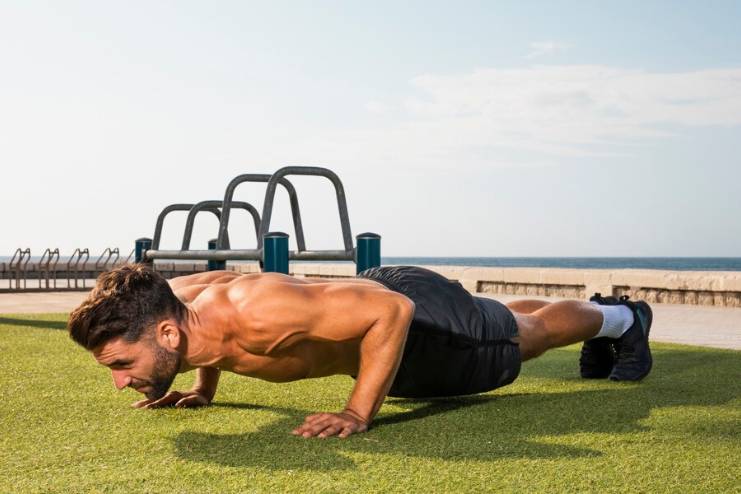
Push-ups are the basic exercises to develop upper body strength and muscle definition, working the chest, shoulders, and triceps.
Proper Form
- Begin on the floor on all fours, positioning your hands slightly wider than shoulder-width apart. Extend your legs back so you are balanced on your hands and toes, forming a straight line from head to heels.
- Tighten your core by pulling your belly button towards your spine. Inhale as you bend your elbows and lower your body until your elbows form a 90-degree angle.
- Exhale while contracting your chest muscles and pushing back up through your hands to return to the starting position. Keep your body in a straight line throughout the movement.
Benefits
- Push-ups engage multiple muscle groups, making them an excellent compound exercise.
- They strengthen the pectoral muscles, deltoids, triceps, and core muscles, including the rectus abdominis and obliques.
- This exercise also improves functional fitness, enhancing your ability to perform everyday tasks that involve pushing movements.
Variations
- Knee Push-Ups: Perform push-ups with your knees on the ground to reduce the load.
- Incline Push-Ups: Place your hands on a raised surface to make the exercise easier.
- Decline Push-Ups: Elevate your feet on a bench to increase difficulty.
- Diamond Push-Ups: Position your hands close together to target the triceps more intensely.
Recommendation
Do three sets with 10-15 reps, ensuring proper form throughout for maximum benefit with reduced risk of injury.
Exercise 2: Dumbbell Shoulder Press
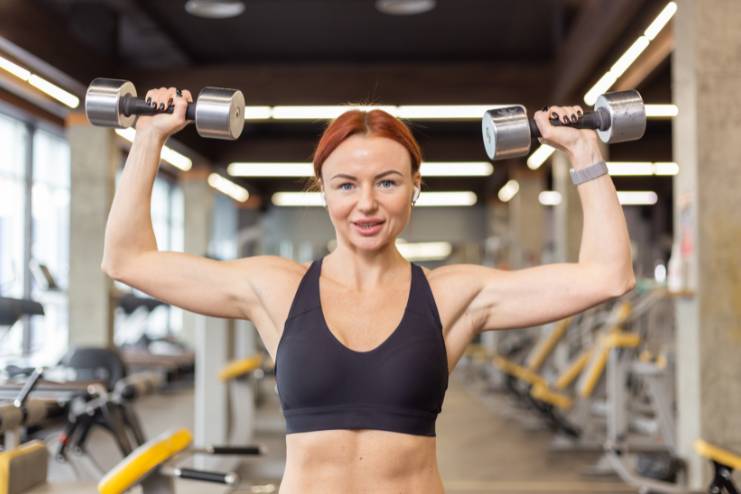
The dumbbell shoulder press is a classic exercise for any shoulder workout. Here is how to do it correctly, for maximum benefit and minimum potential injury:
- Stand with feet shoulder-width apart, holding a dumbbell in each hand. Brace your core and squeeze your glutes to stabilize your body. Your elbows should be at a 45-degree angle to your body, with your hands at ear level.
- Press the dumbbells upward until your arms are almost fully extended, but avoid locking your elbows. Your palms should face forward, and your shoulders should remain down and away from your ears to prevent overextension.
- Lower the dumbbells back to the starting position with control. This eccentric phase is crucial for muscle development and injury prevention. Aim for a slow, controlled descent over 1-3 seconds.
- Inhale as you lower the weights and exhale as you press them overhead.
Benefits
The dumbbell shoulder press works on the front deltoids and the triceps to increase force in the shoulders. It will keep you working for enhanced strength of the upper body and improve your posture.
Recommendation
Do 3 sets of 10-12 reps for best results. Keep good form throughout each set, so as to really work those muscles and not hurt yourself.
Exercise 3: Bent-Over Rows
With a Barbell:
- Stand with your feet shoulder-width apart, knees slightly bent.
- Hold the barbell with an overhand grip, hands slightly wider than shoulder-width apart.
- Hinge at the hips, pushing your hips back while keeping your back straight.
- Lean your torso forward until it is almost parallel to the floor, keeping your core tight.
- Pull the barbell towards your hips in an arc shape, squeezing your shoulder blades together at the top of the movement.
- Keep your elbows close to your body.
- Pause briefly at the top, then slowly lower the barbell back to the starting position.
With Dumbbells:
- Stand with feet shoulder-width apart, knees slightly bent.
- Hold a dumbbell in each hand with a neutral grip (palms facing each other).
- Hinge at the hips, pushing your hips back and keeping your back straight.
- Lean your torso forward until it is almost parallel to the floor, maintaining a tight core.
- Row the dumbbells towards your hips, keeping your elbows close to your body and squeezing your shoulder blades together at the top.
- Pause briefly at the top, then slowly lower the dumbbells back to the starting position.
Benefits for Back Strength and Posture
- Enhanced Muscle Activation:
- Bent-over rows train muscle groups such as the trapezius, rhomboids, latissimus dorsi, biceps, rear deltoids, abdominals, and glutes.
- This exercise will also provide massive strength and muscle gain for the overall upper body, important for a well-balanced physique.
- Improved Posture:
- Strengthening the upper back muscles will balance the negative effects of a poor posture, especially in people who sit most of their time.
- Bent-over rows, when practiced regularly, help you develop a neutral spine and can help you in preventing a hunched back.
- Increased Functional Strength:
- This exercise mimics pulling movements that are common in daily activities, enhancing functional strength and making everyday tasks easier.
- Core Stability:
- Maintaining a proper bent-over position requires core engagement, which contributes to overall core stability and strength.
Recommendation
3 sets of 10-12 reps:
- Aim for 10-12 repetitions per set.
- Rest for 60-90 seconds between sets.
- Focus on controlled movements to maximize muscle engagement and reduce the risk of injury.
Additional Tips
- Proper Form: Always prioritize good form over lifting heavier weights to prevent injury.
- Breathing: Exhale while lifting the weight and inhale while lowering it.
- Warm-Up: Include a proper warm-up to prepare your muscles and joints for the exercise.
Adding bent-over rows to your workout routine gives you a bigger and better-defined back, stronger posture, and increased upper-body strength.
Exercise 4: Bicep Curls
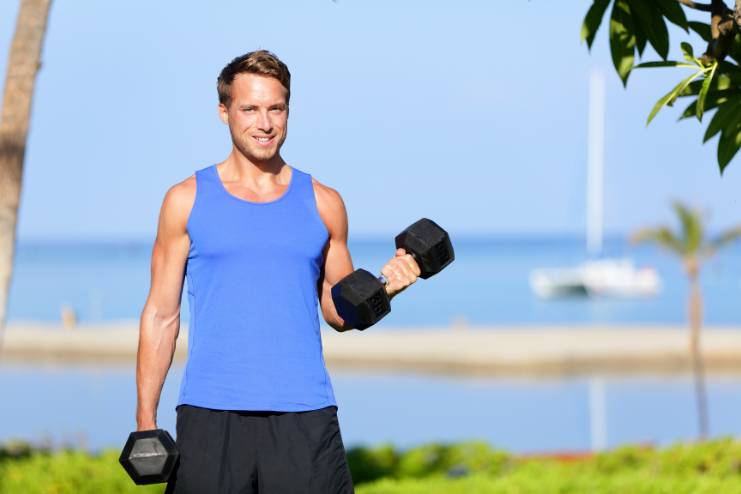
One of the main exercises for the arms is the bicep curl. This targets the biceps for muscle definition and strength. To perform the dumbbell bicep curl:
- Stand tall with feet hip-width apart. Hold a dumbbell in each hand, arms fully extended, and palms facing forward.
- Keep your upper arms stationary and elbows close to your body. Bend your elbows to lift the dumbbells towards your shoulders, exhaling as you lift. Ensure a controlled movement without using momentum.
- Slowly lower the dumbbells back to the starting position while inhaling, maintaining control to maximize muscle engagement.
Benefits
Bicep curls increase bicep strength and muscle definition. While the biceps brachii is the primary muscle used in this exercise, it does utilize the brachialis and brachioradialis of the forearms.
Recommendations
Do 3 sets of 12-15 reps for optimal results. Adjust the weight to a level where the last few reps in each set will be hard to do but still can do it without compromising on form.
Exercise 5: Tricep Dips
Triceps dips are one of the decent exercises that work well for both upper body strength and arm definition. You can perform tricep dips on parallel bars or on a bench. Here’s how:
- Sit on the edge of a stable chair, bench, or parallel bars. Grip the edge next to your hips with your fingers pointing forward. Extend your legs, keeping your heels on the ground and feet hip-width apart. Look straight ahead.
- Press into your palms to lift your body and slide forward until your buttocks clear the edge. Lower your body by bending your elbows until they form a 45-90 degree angle. Control the movement.
- Push yourself back up until your arms are almost straight, maintaining tension in your triceps. Repeat for the desired number of repetitions.
Benefits
Tricep dips work the triceps brachii muscles at the back of your upper arm, responsible for elbow extension and pushing movements. Benefits to this exercise include engaging your core for stability and improved arm definition.
Recommendations
Do 3 sets of 10-12 reps for best results. Be careful with the form and avoid straining your shoulders and elbow joints. Add some tricep dips into your routine for stronger and defined arms.
Cool Down
A good cool-down session supports the recovery of muscles and offers flexibility. Here is a 5-10 minute cool-down session with static stretches that target the upper body:
Chest Stretches
- Behind-the-Back Elbow-to-Elbow Grip
- Stand or sit with arms hanging by your sides and shoulders pressed down. Squeeze shoulder blades together, broadening the chest. Bring arms behind the back and grip elbow to elbow.
- Hold for 10-30 seconds, repeat 2-4 times.
- Above-the-Head Chest Stretch
- Bend elbows and interlock fingers behind your head, either seated or standing. Squeeze shoulder blades together and move elbows backward.
- Hold for 10-30 seconds, repeat 2-4 times.
Shoulder Stretches
- Cross-Arm Stretch
- Bring your left arm across your body at chest height. Support it with your right arm.
- Hold for 30 seconds, switch sides, repeat 2-3 times.
- Bent-Arm Wall Stretch
- Assume a split stance at a wall or doorway. Bring left arm up to shoulder height, placing the palm and inside of the arm on the wall. Elbow should be bent at 90 degrees.
- Press chest through the space to stretch. Hold for 10-30 seconds, switch sides, repeat 2-4 times.
Arm Stretches
- Extended Child’s Pose on Fingertips
- Kneel on the floor with big toes touching and sit back on heels. Separate knees to hip-width. Bend forward, extending arms in front, coming onto fingertips.
- Hold for 10-30 seconds, repeat 2-4 times.
- Eagle Arms (Garudasana)
- Stretch arms out to the sides, then swing right arm under the left and grab opposite shoulders, or wrap forearms around each other if flexible.
- Lift elbows slightly and relax shoulders. Hold for a few breaths, switch sides, repeat 2-3 times.
Conclusion
Upper body strength and definition routines improve muscle tone, enhance posture, and increase functional strength. A well-developed upper body gives you a balanced physique.
References
- https://www.healthline.com/health/fitness-exercise/arm-exercises-no-weights
- https://www.healthline.com/health/tight-shoulders
- https://www.healthline.com/health/fitness/resistance-band-chest-workout
- https://ericrobertsfitness.com/how-to-do-dumbbell-shoulder-press-the-correct-guide
- https://www.verywellfit.com/the-push-up-exercise-3120574
- https://www.menshealth.com/uk/building-muscle/a757301/how-to-master-the-bent-over-row
- https://www.verywellfit.com/how-to-do-the-biceps-arm-curl-3498604
- https://www.verywellfit.com/the-chair-dip-triceps-exercise-3120734
- https://www.acefitness.org/resources/everyone/blog/5657/5-chest-stretch-variations
- https://www.healthline.com/health/tight-shoulders
In this Article















